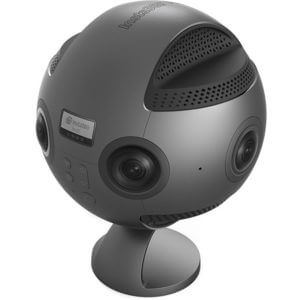It’s no secret that marketers and consumers the world over have been bit by the 360º VR video bug. Case and point: a year and a half ago we didn’t know much about this emerging technology; and now, we’re masters of the craft, providing top-tier 360º VR video content for a ton of clients. We expanded our knowledge and our capabilities to keep pace with one of hottest trends in modern video production. And the fact that it’s super cool tech does help fuel our efforts, I must admit.
But on our path to VR video production expertise, we’ve realized that a lot of people—clients included—don’t know the difference between monoscopic and stereoscopic 360º video. In layman’s terms, that like not knowing the difference between a cheeseburger and a Philly cheesesteak.
They’re both great and totally enjoyable, but they’re also very different things. What’s more, you may think you want one, when really, once you see the final product, you realize you actually wanted the other.
It can be confusing, I know. But never fear: I’m here to set the record straight once and for all. Goodness knows we don’t want any more cheeseburger-Philly cheesesteak mix ups! So, without further ado…
Making Sense of Monoscopic 360º Video
What is monoscopic 360º video? In terms of the delicious analogy I’ve laid out, monoscopic 360º video would be the cheeseburger. It’s great and it’s super satisfying, but ultimately it’s the more basic of the two options.
If you want to get all technical, monoscopic 360º video is just flat equirectangular video displayed on spherical interface.
Now, you’re probably thinking, “there he goes spouting off all those fancy tech words again.” Well, think of it like this: watching monoscopic 360º video is like standing in a perfectly circular room made of glass.
You can see everything going on outside the room—people walking to work, fish swimming, etc.—but nothing ever seems to get closer or further away. As you turn your head, the head-tracking technology built into your device moves the image correspondingly. This is what creates the sensation of being “in” a scene.
But, as immersive as monoscopic 360º video is, it’s a far cry from the visuals that have actual depth to them. I’m talking about visuals that really and truly look like you can reach out and touch them. No, if you’re looking for something of this ilk, you’re gonna need to…
Get The Scoop on Stereoscopic 360º Video
What is stereoscopic 360º video? This, my friends, is the Philly cheesesteak in our analogy. It’s delicious. It’s beloved. And though a lot of people can make one, making one right takes nuance and a complete understanding and reverence for the ingredients.
Remember the better half of a decade ago when James Cameron’s Avatar (2009) dropped and everyone lost their collective shit over 3D movies? Sure: Cameron’s a narrative crook whose latest films have as much depth as an episode of Keeping Up With the Kardashians. But none of that matters. Because the world at large ate Avatar up like a freshly-stoned teen listening to a Phish album for the first time.
It’s fair to say that Avatar single-handedly brought 3D video—or stereoscopic video—to the forefront of Hollywood’s attention. Since then, dozens of multi-million dollar blockbusters have been shot using this technology.
This effect might seem hard to manufacture, but really it’s as easy as shooting with 2 lenses side by side. By shooting like this, the footage mimics the optics of your eyes, with two different vantage points in each lens. Most importantly, this gives you depth data, which is what gives stereoscopic video its signature 3D effect.
Taking this even further, stereoscopic 360º VR cameras capture footage that can be stitched together to render life-like 3D 360º environments. Whereas a monoscopic 360º camera uses, say, 4 cameras to film an environment, a stereoscopic 360º camera like the Nokia Ozo or the Insta360 Pro uses 6 or 8, respectively.
For those of you counting along, that’s 4 lenses for the right eye and another 4 for the left. From the wilds of the Amazon to the confines of a newly-remodeled kitchen, stereoscopic 360º VR video makes you feel like you can actually reach out and touch it.
Decisions, Decisions: Cheeseburger or Philly Cheesesteak?
We know that you’re hungry. Seeing both that cheeseburger and Philly cheesesteak sitting in front of you is surely drool-inducing. But, unless you have a HUGE appetite—and a deep wallet to match—you can only eat one or the other.
So, what will it be: cheeseburger or Philly cheesesteak? Now that you know the difference between monoscopic 360º video and its stereoscopic counterpart, which one works best for your project? Don’t worry, I’ll wait…
…
Okay, okay: I know this decision is hard. Picking the wrong item from the menu sucks. But if you stay tuned for Taste The Difference, Pt. 2, I’ll give you a full rundown of both menu items. Their pros and cons, challenges and benefits, all that good stuff.
Until then, please feel free to leave questions or comments below! And please: make sure you eat some actual food.





2 Responses
I completely agree! As someone who has tried both mono and stereo 360° VR videos, I can definitely taste the difference. The immersive experience of stereo 360° VR videos is unparalleled. The ability to “be there” in the scene and feel like you’re truly part of the action is what makes it worth the extra effort. Great post!